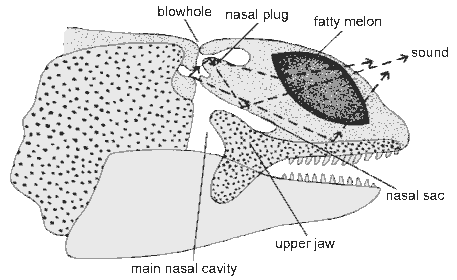
|
sound production |
dialects |
catalogue of Kamchatkan killer whale calls
Sound production
The data on mechanisms of sound production in toothed whales are contradictory. While
some researchers suppose that the larynx and structures around the
larynx of toothed whales are involved with sound production, others
believe that the whales have evolved new mechanisms for sound production.
The nasopharyngeal anatomy of cetaceans is strongly modified comparing with terrestrial
mammals. They have one impair
 |
respiratory hole at the top
of the head. It is closed near the surface by dense musculocutaneous
crimps arranged so, that the salient of one of them enters
into the dimple of another. They form a peculiar lock preventing
the water from penetrating into respiratory tract. Above the
skull around of nose passage there is a system of pneumatic
sacs, connected with nose passage (Kleinenberg et al.,
1964). In 1964 A.V.Jablokov supposed |
that sounds could be produced by forcing air through these nasal sacs. Air is forced pasta set of finely striated muscular plugs or lips that vibrate
or slap against each other as the lips are forced apart by the stream
of air and then slapped shut by muscular tension (Popper et al.,
1997).
Dolphins rarely emit bubbles while producing echolocation clicks,
and it is assumed that air can be stored in the nasal vestibule
just beneath the blowhole and recycled past the muscular plugs.
Although only one nasal exit or blowhole is seen externally, from
the blowhole down dolphins possess two separate nasal passages.
Both are presumptively capable of producing sound. At present it
is not known, whether one nasal passage is used to produce clicks,
or the separate sounds from two nasal passages interact non-linearly
to produce a sound beam emitted from forehead. It is possible also,
that dolphin may be able to produce whistles and other social sounds
with one nasal passage while producing echolocation clicks with
the other (Popper et al., 1997). Sounds produced by two different
sources (biphonation) are common in dolphins. In some cases up to
40 % of signals include biphonation (Markov, Tarchevskaya 1978).
For killer whales was also reported the ability to produce two different
signals simultaneously, either whistles or echolocation clicks or
harmonic sounds with different fundamental frequency (Dahlheim,
Awbrey 1982, Ford 1984).
Killer whales, as well as most of Delphinidae
species, has a large vocal repertoire. Sounds of killer whales fall
into three main classes: clicks, whistles and pulsed calls.
Clicks are brief pulses of sound, typically given in series and used
mostly for echolocation. Oscillogram of a pulsed sound looks like
a set of pulses, which can be caused by impulse nature of sound source
as well as redistribution of energy from lower harmonics to higher
ones by filtration. In the first case frequency bands on the sonogram
should be interpreted as sidebands appearing at intervals equivalent
to the pulse repetition rate; in the second case pulse repetition
rate will be the fundamental frequency, and pulse frequency will be
the dominant frequency. The first interpretation is more common now
(Ford 1984, 1989, 1991, Yurk et al. 2002), and in this work
we also will follow this hypothesis, although without detailed study
of cetacean sound production mechanisms all this theories are nothing
more than speculations. Whistles are characterized by a non-pulsed
waveform, which appears on a sonogram as a single narrowband tone
with little or no harmonic or sideband structure. There are also some
intermediate sounds without pronounced pulsed structure, but with
clear harmonics or sidebands and energy redistribution to the higher
harmonics. Pulsed sounds usually contain abrupt frequency shifts,
many of them also have an overlapping whistle component (Ford 1984).
The majority of killer whale pulsed signals fall into discrete structural
categories with higher or lesser variability inside them. Discrete
calls are used to maintain contact between group members, especially
when animals are dispersed, for example during foraging. Discrete
calls predominate in killer whales acoustic communication. However,
in their repertoire occur also highly variable calls that cannot be
classified into clearly-defined categories (Ford 1984). This
variable calls include complex, intergrading signals ranging from
low-frequency rumbling and squeaks to high-frequency squawks of different
duration.
Vocal dialects Long-term investigations of killer whale acoustic behavior in different
parts of the world (Canada (Ford 1984, 1991), Alaska (Yurk
et al., 2002), Norway (Moore et al., 1988, Strager 1995))
showed that each pod has its own unique repertoire of discrete calls,
practically stable during tens of years and passing from mother to
offsprings by vocal learning. This phenomenon was called vocal dialects.
It is widespread and well-studied among birds (Kroodsma & Miller,
1996), but in mammals it is known to occur only in cetaceans,
phocid seals, bats and humans (Janik & Slater, 1997). Among cetaceans,
vocal dialects exist in killer whales (Ford 1984, 1991, Moore et
al., 1988, Deecke et al. 2000, Miller & Bain 2000, Yurk et al.,
2002) and sperm whales (Weilgart & Whitehead 1995, Rendell
& Whitehead 2002). Differences in acoustic repertoires of
some terrestrial mammals are usually the results of geographic isolation
and thus represent not dialects but geographic variations of vocal
repertoire (Ford 1984).
Pods each produces 7-17 types of discrete calls. Some of the calls
are shared by several pods and some are unique. Pods that share calls
belong to the same acoustic clan. Different clans appear to represent
independent maternal lineages that have persisted for many generations,
and have independent call traditions.
Kamchatkan orcas also have their own system of vocal dialects. Here is the recordings of two groups - difference between them can be easily detected by ear.
|
|
|

|


